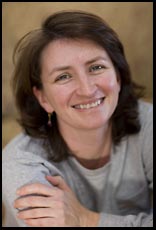
Canon EF 85/1.2L II USM Lens Review
by Philip Greenspun; created February 2008
Site Home : Photography : EF 85/1.2L II

by Philip Greenspun; created February 2008
Site Home : Photography : EF 85/1.2L II
The Canon 85/1.2L lens is Canon's fastest and highest quality short telephoto lens. It is designed for full-frame digital SLRs such as the 5D. If you are passionate about portraits in available light, there is no better lens within the Canon system.
What's so exciting about an f/1.2 lens? In medium light, the lens can produce an extremely shallow depth of field, throwing any background distractions out of focus. In low light, the lens supports reasonable motion-stopping shutter speeds without forcing the photographer to choose a high noise ISO 1600 or ISO 3200.
The lens was redesigned early in 2006 and now carries a "II" designation. The earlier version of the lens was a very high quality optic, but the new version, at a slightly increased price, offers improved autofocus speed and transmits focus distance information to the camera, increasing the accuracy of flash exposure.
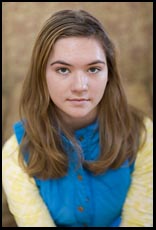
What kind of photographer earns enough money taking pictures of people to recoup the cost of this lens? A wedding photographer. Here's how to use the Canon 85/1.2L at a wedding:
How close does the Canon 85/1.2L lens focus? Can you take a picture tightly cropped around a friend's head? You might need to bang your friend's head against the studio wall, then wait a few hours until it swells up to the size of a prize-winning watermelon. Maximum image magnification is 0.11X. On a full-frame camera, this is good for a head-and-shoulders photo, but not sufficient for a head-only picture (comparison: the 70-200/2.8L lens focuses down to a magnification of 0.17X). For studio portraiture, you might find it convenient to work with the EF 12 II extension tube. You'll lose the ability to focus at infinity with this tube attached, but maximum magnification is increased to 0.25X.
How about depth of field? At the five foot distance that would be typical for an upper body portrait, the depth of field at f/1.2 is only about one inch, i.e., at typical enlargement sizes and viewing distances, objects between 1/2" behind the subject's eyes to 1/2" ahead of the subject's eyes will be acceptably sharp. You'd better hope that the subject doesn't move, which unfortunately is the surest way to get terrible photos. As soon as the average person is forced to freeze, he or she takes on a strained expression.
What does this mean as a practical matter? Consider the 100 percent crop (below) from an EOS 1Ds Mark III 21 megapixel image, taken at f/1.2. The eyebrow is in sharp focus. The eye is soft. The full size image is at the lower left hand corner of the matrix below.
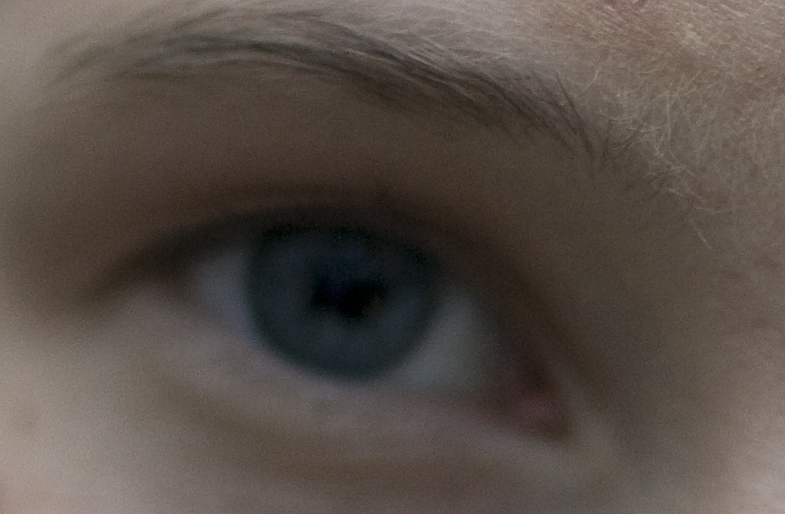
At f/2.0, the depth of field expands to roughly 3/4" on either side of the focus plane. At f/2.8, the depth of field is 1" on either side. Even at f/8, the depth of field is only about 3" on either side. Note that these numbers are for a full-frame body.
| f/1.2 | f/1.4 | f/2.0 | f/2.8 | f/4.0 |
|---|---|---|---|---|
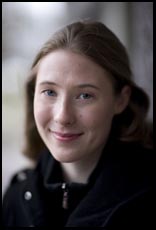 |
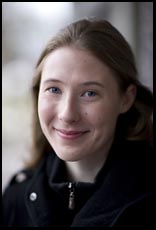 |
 |
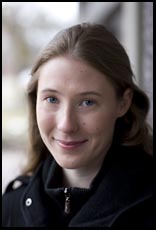 |
 |
 |
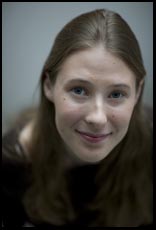 |
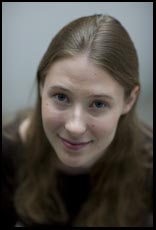 |
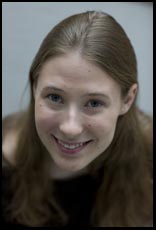 |
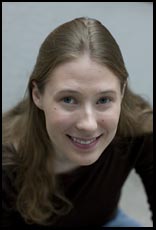 |
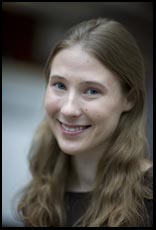
|
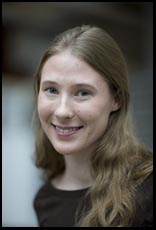
|
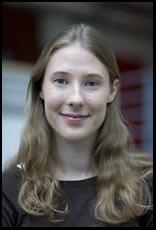 |
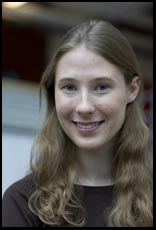 |
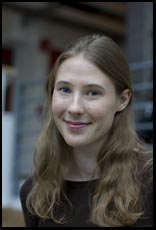 |
In order to facilitate viewing, single lens reflex cameras keep the lens wide open until an instant before exposure. The brightness of the viewfinder does not depend on the aperture that you've set for the photo; the brightness of the viewfinder is determined by the maximum aperture of the lens. Mounting an f/1.2 prime lens instead of a typical f/2.8 professional zoom will send six times as much light to the viewfinder, yielding roughly an apparent doubling of brightness.
The shallow depth of field at f/1.2 also helps a photographer evaluate focus. Subjects will snap in and out of focus more dramatically than with a slower lens. The autofocus system also has an easier time working, especially on dimly lit scenes.
Canon doesn't put sensor-based image stabilization in its bodies and they didn't put an optical image stabilizer in this lens. The f/1.2 aperture helps by enabling the photographer to select higher shutter speeds, but to minimize camera shake you'll find yourself leaning up against door frames or using electronic flash. If you can't find a door frame, remember that you need a shutter speed of 1/80th of a second or less to freeze typical camera shake at typical magnifications.
The lack of image stabilization makes this lens more of a portrait/blurred background champ than a low-light-without-tripod champ.
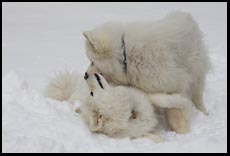
The Canon 85/1.2L incorporates a ring-type ultrasonic motor, for instant autofocus and the option of touching up the focus manually even in autofocus mode. The lens lacks internal focus so the front element moves forward and back slightly as the focus is adjusted. However, the front element does not rotate as you focus, making it easy to use this lens with polarizing filters.
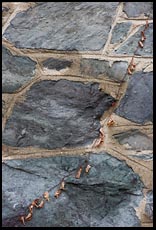
The Canon 85/1.2L has the kind of rugged mechanical construction that you would expect given the heavy chunks of glass inside. The lens lacks the rubber gasket around the all-metal mount that is typical of other L-series lenses, such as the 70-200/2.8 and 16-35/2.8. Do not expect better resistance to rain than you would get with an 85/1.8 or other non-L lens.
The lens barrel incorporates 8 elements of glass in 7 groups. One of those 8 glass elements is aspherical.
The diaphragm is an 8-blade design for nearly circular appearance in out-of-focus highlights. Filter size is 72mm and the clip-on ES-79 II hood is included.
The penalty for all of this quality is a shoulder-crushing weight of 1025g, more than 2 lbs. and twice as much as a Canon Digital Rebel body.
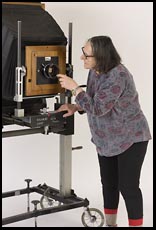
As digital camera bodies add more pixels, one wonders whether or not lens resolution will be the limit on image quality. At right is a studio test with the 85/1.2L at f/8, the aperture that produced the highest quality results on Canon's modulation transfer function graph (see link below). The body was the EOS 1Ds III set to "ISO L" (50) because we could not dial down the studio strobes sufficiently to use the native ISO 100 setting. The subject is Elsa Dorfman, Boston's best-known portrait photographer, with her 20x24" Polaroid camera.
Below is a crop from the original 21 megapixel image. The cropped image is presented at 100 percent, i.e., each pixel in the image below is one pixel from the camera. The crop image was filtered with Unsharp Mask at the following settings: 75 percent, 1 pixel radius, 0 threshold. It was then saved in .png format.
What's the limiting part of the imaging system here, the camera body or the 85/1.2L lens? Look at the lack of contrast and the softness of the "Fuji Photo Optical" lettering around the lens. These are not distortions that you would expect from the CMOS sensor in the 1Ds Mark III. These are typical problems that one expects at the resolution limit of a lens.


If your wallet and shoulder can't support the price and weight of the 85/1.2L lens, consider the 85/1.8. You lose one f-stop of speed, which means that you will need twice as much light, but the 85/1.8 is an excellent lens and balances better on the lighter digital bodies, such as the Rebel series.
If portraits are not the main objective of an assignment, the 70-200/2.8L covers the 85mm focal length with superb image quality and image stabilization as well.
Nikon produces a very high quality 85/1.4 that is in between the Canon 85/1.2 and 85/1.8 in price and weight. There was Pentax 85/1.4 lens, but it has been discontinued. Sony offers a relatively new 85/1.4 lens for their digital bodies. The Canon EOS lens mount is a bit larger than competitive lens mounts, which is why Canon has been able to produce crazy fast lenses such as the 50/1.0 and the 85/1.2.
This is an EF lens, illuminating an image circle large enough to cover a 24x36mm piece of film or the sensor in Canon's more expensive "full-frame" digital SLRs. The lens will work fine on a small-sensor body, but you will be carrying around ridiculously more glass than you need. On the plus side, the equivalent focal length will be closer to 130mm, which provides more telephoto compression of features and a greater working distance from the subject.
Given that (1) a 50mm lens on a small sensor body gives the same perspective as a 75mm lens on a full-frame body, (2) a 75mm lens and an 85mm lens are awfully close in perspective, (3) an f1.4 lens is just as useful as an f/1.2 lens 95 percent of the time because it is so seldom that one wants to take pictures at f/1.2, and (4) a 50/1.4 and Digital Rebel body cost less than the 85/1.2L, ... why wouldn't a Digital Rebel and Canon 50/1.4 lens work just as well as an 85/1.2L lens on a full frame body?
For taking pictures in available light, the 50/1.4 and Digital Rebel would work reasonably well, with the caveat that a small sensor body will nearly always have more noise at high ISOs than a full-frame body. Where the 50/1.4 on a small sensor body is not equivalent to an 85mm lens used at f/1.4 on a full frame body is in depth of field. The 85mm lens at f/1.4 and 5' has a depth of field only +/- 0.5 inches. The 50mm lens at f/1.4 and 5' has a depth of field of +/- 1.5 inches. The dreamy look of the portrait may well be gone.
 |
At f/2.8 the depth of field is still fairly shallow. The out of focus areas are smooth and not too distracting. |
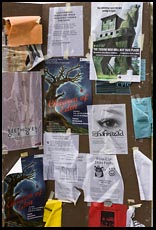 |
Handheld at f/4.5 and 1/160th, ISO 250 on an EOS 1Ds Mark III. Despite a bit of motion blur, there is enough detail in this full size JPEG to read nearly every word on the poster board. |
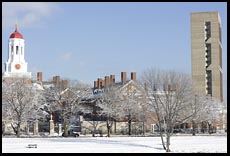 |
f/8 and 1/250th on a sunny day at ISO 100. Look at the full size JPEG and scroll around to look at detail. |
| Focal length | 85 mm |
|---|---|
| Maximum aperture | F1.2 |
| Minimum aperture | F16 |
| Angle of view | • Horizontal: 16° • Vertical: 24° • Diagonal: 28° - 30' |
| Lens construction | 8 elements in 7 groups |
| Diaphragm blades | 8 |
| Closest focusing distance | 95 cm (3 feet) |
| Maximum magnification | 0.11x (not enough for tight head shot) |
| Distance information | Yes |
| Image stabilizer | none |
| AF actuator | Ring USM (full-time manual focus built-in) |
| Filter diameter | 72 mm |
| Dimensions (dia x len) | 91.5 x 84 mm |
| Weight | 1025 g (2.26 lb) |
| Max magnification with extension tubes | EF 12 II: 0.25 EF 25 II: 0.45 |
| Lens hood | ES-79 II |
| Soft case | LP1219 |
| Extenders | EF 1.4x II: Not compatible EF 2.0x II: Not compatible |
Text and pictures copyright 2008 Philip Greenspun